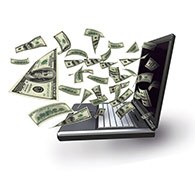НАВИГАЦИЯПОПУЛЯРНЫЕ СТАТЬИ
|
Growth in 2005 was a paltry 1.4 percent in the Eurozone, and Germany`s resurgence after years in the doldrums has convinced politicians, economists and investors alike that Europe is back on track after several years of economic drift. Two million jobs were created in 2006 and an unemployment rate of 7.6 percent was the lowest since records started being published by EU statistics office Eurostat, Almunia said, promising revisions to official growth forecasts for February 16. 08.02.2007 20:56 Russian GDP index signals slower manufacturing growth The Russian Gross Domestic Product Indicator, produced by NTC Research for VTB Bank Europe, pointed to a further marked rate of economic growth at the start of 2007. The indicator posted 7.4 percent, slightly above the average annual rate of growth signaled during 2006 which, at 7.3 percent, was the highest calendar average since 2000. However, the indicator signaled a slowdown in growth for the third successive month from the 2.5-year peak of 7.8 percent registered last October. The All Industry Index rose slightly in January, to 58.9, from levels of 58.5 recorded during November and December. Inflation in Russia in January 2006 amounted to 1.7%, the Federal State Statistics Service said. Inflation in January 2006 ran at 2.4%, and in January 2005 - 2.6%. Average daily price growth in the country in January 2007 was 0.054%, compared with 0.077% in January 2006. The government forecasts price growth in 2007 of 6.5%-8%. 06.02.2007 21:47 Economic growth in the eurozone is expected to be at 2.5 percent of GDP in 2006 Economic growth in the eurozone would be at 2.5 percent of GDP in 2006 and was expected to see a further upturn, Bank of Spain said. The eurozone economy is currently enjoying the strongest growth since the turn of the century, pumping unexpected revenues into government coffers. Real GDP in the eurozone decelerated slightly in Q3 2006 (0.5%) after the strong increase registered in H1. The prospects for economic growth remain however positive. Real GDP is expected to rise by 0.7% in Q4 2006, followed by 0.3% in Q1 2007 and 0.5% in Q2. Industrial production should continue to expand, but at lower rates, owing to the expected slackening in world trade. Domestic demand is bound to exhibit resilience. Consumption should remain robust after a temporary slowdown in Q1 2007 associated with the German VAT hike. Investment should expand at a constant but still strong rate. On the technical assumption that oil prices stay within a range of USD 60-65 per barrel of Brent and that the dollar/euro exchange rate fluctuates around 1.30, consumer price inflation is expected to jump, reflecting the VAT rise in Germany, to 2.1% in Q1 2007 before decreasing to 1.7% in Q2. 04.02.2007 11:42 U. S. ISM Manufacturing Index Falls to 49.3 in January 2007 The Institute for Supply Management`s manufacturing index fell to 49.3, the lowest since April 2003, from December`s 51.4, the private industry group said today in Tempe, Arizona. Readings less than 50 signal contraction. The report suggests last quarter`s production slump may carry over into 2007 as construction slows and automakers trim inventories of unsold vehicles. A factory setback would restrain growth and keep Federal Reserve policy makers on the sidelines, neither raising nor lowering interest rates, in coming months. The manufacturing index was projected to rise to 51.7, according to the median estimate of 72 economists surveyed by Bloomberg News. The index averaged 53.9 in 2006. The supply managers` group`s measure of prices paid for raw materials rose to 53 from 47.5 the month before. The Tempe, Arizona-based institute`s new orders index, which makes up about a third of the total, fell to 50.3 from 51.9. The production index, a measure of work being performed, dropped to 49.6 from 52.4. The inventory index slumped to 39.9, the lowest since February 2002, from 48.5. The 8.6-point decline was the biggest since 1984. The large correction in inventory may shorten the factory slowdown, some economists said. 31.01.2007 20:50 Real US GDP increased 3.5 percent in the fourth quarter of 2006 Real US gross domestic product (GDP) increased 3.5 percent in the fourth quarter of 2006 after increasing 2.0 percent in the third quarter, according to estimates released today by the Bureau of Economic Analysis. Annual growth in 2006 was 3.4 percent, compared with 3.2 percent in 2005. The rise of 3.4% in 2006, compared to a 3.2% increase in 2005 and 3.9% growth in 2004. Inflation indicators within the GDP report indicated that consumer prices softened significantly during the fourth quarter. The price index for personal-consumption expenditures (PCE) fell, declining by 0.8% after rising 2.4% in the third quarter and 4.0% in the second quarter. The fall was the biggest since 1.2% in third-quarter 1954, fuelled by declining energy costs. The PCE price index excluding food and energy rose 2.1%, after increasing 2.2% in the third quarter. The price index for gross domestic purchases, which measures prices paid by US residents, only rose 0.1%, after rising to 2.2% in the third quarter. The chain-weighted GDP price index increased 1.5%, after rising 1.9% in the third quarter. 27.01.2007 12:04 The Japanese economic growth will accelerate next fiscal year The Japanese economic growth will accelerate next fiscal year as corporate profits spread to households, fueling consumer spending, the government said. The world`s second-biggest economy will probably grow 2 percent in the year starting April 1 from 1.9 percent in the current period, the Cabinet said. The Japanese economic expansion, the longest in the postwar era, is being driven by business investment and exports amid a slump in consumer spending. Slower export growth as global demand cools will make the economy more reliant on a rebound in spending by Japanese households. "The economic recovery will be driven by the private sector", - the government said in the report. "Solid corporate profits will spread to households through improvement in the job market and wages". 25.01.2007 20:40 China GDP growth fastest in a decade Economy of China expanded faster than expected in 2006 with a full-year growth of 10.7%, according to published reports. Gross domestic product increased 10.4% in the fourth quarter of 2006 - an expansion that some predict will continue into 2007. But weak consumer spending and low farm income remains a concern for the government given the high values in banking, Xie Fuzhan, commissioner of the National Bureau of Statistics, told a news conference today, reports said. Officials have passed measures to clamp down on foreign investment with limits on construction and money lending by banks. In addition, China may soon end tax breaks for foreign companies as they are not necessary to stimulate growth anymore, reports said. The country will now refocus on growth in domestic companies. 22.01.2007 21:37 Russian industrial output grew 3.9% in 2006 Russian industrial output grew 3.9%, year-on-year, in 2006, the Federal State Statistic Service (Rosstat) said. Rosstat said industrial production increased 1.9%, year-on-year, and 4.9%, month-on-month, in December 2006. Industrial output expanded more slowly in December 2006 compared with December 2005, as heat generation fell 8.2% due to warm weather. Industrial production increased 3%, year-on-year, in the fourth quarter of 2006, with output growing 1.9% in Q4 and 2.3% in 2006 in mining, 3.8% and 4.4%, respectively, in manufacturing industries, and 1.3% and 4.2% in electricity, gas and water production and distribution. In 2006, Russia produced 309 million metric tons of coal (up 3.6% on 2005), 480 million metric tons (3.5 billion barrels) of oil (an increase of 2.1%), and 656 billion cubic meters of gas (a growth of 2.4%). Car production expanded 9.9% in 2006, to 1.2 million vehicles, the service said. 19.01.2007 21:02 U. S. Industrial Production Rises 0.4% in December 2006 Industrial production in the U. S. rose more than forecast in December 2006, driven by demand for computers, home electronics and automobiles. Production at factories, mines and utilities rose 0.4 percent, following a 0.1 percent November drop, the Federal Reserve said this week. Capacity utilization, which measures the proportion of plants in use, rose to 81.8 percent, from 81.6 percent a month earlier. Manufacturing, which accounts for about four-fifths of the industrial production report, rose 0.7 percent last month, the most since June, after no change the prior month. Excluding autos, factory production rose 0.6 percent and followed a 0.3 percent drop in November. Mining output in the U. S. rose 0.8 percent last month, following a 0.4 percent decrease. |
Цитата дняБольшинство людей начинают интересоваться акциями, когда все остальные интересуются. Время интересоваться — это когда никто другой не интересуется. Вы не можете купить что-либо популярное и выиграть от этого. |




 14.02.2007 22:36 the World Bank`s projection for China`s GDP growth in 2007 remains unchanged at 9.6% China`s economic growth is expected to fall to 9.6% this year from 10.7% last year amid a mild slowdown in exports, the World Bank said. Export growth is likely to decline to 20% this year, from 24% in 2006. "A resilient world economy means that export demand prospects remain good, although less buoyant than in 2006", - the report said. The World Bank said productivity growth meant exporters would probably be able to continue absorbing the effect of a rising currency and the gradual lowering of export tax rebates. Investment, a main engine of growth in the world`s fourth largest economy in recent years, is unlikely to slow drastically in early 2007, while consumption should grow solidly. 12.02.2007 22:30 Eurozone economy will be in a strong position this year Eurozone`s gross domestic product probably grew 2.6 percent in 2006, and this year was also likely to top existing forecasts of 2.1 percent, said European Economic and Monetary Affairs Commissioner Joaquin Almunia. "The current economic situation remains very positive", he added.
14.02.2007 22:36 the World Bank`s projection for China`s GDP growth in 2007 remains unchanged at 9.6% China`s economic growth is expected to fall to 9.6% this year from 10.7% last year amid a mild slowdown in exports, the World Bank said. Export growth is likely to decline to 20% this year, from 24% in 2006. "A resilient world economy means that export demand prospects remain good, although less buoyant than in 2006", - the report said. The World Bank said productivity growth meant exporters would probably be able to continue absorbing the effect of a rising currency and the gradual lowering of export tax rebates. Investment, a main engine of growth in the world`s fourth largest economy in recent years, is unlikely to slow drastically in early 2007, while consumption should grow solidly. 12.02.2007 22:30 Eurozone economy will be in a strong position this year Eurozone`s gross domestic product probably grew 2.6 percent in 2006, and this year was also likely to top existing forecasts of 2.1 percent, said European Economic and Monetary Affairs Commissioner Joaquin Almunia. "The current economic situation remains very positive", he added. Автор:
Автор: 
 Комментарии: 0
Комментарии: 0 Просмотров: 23
Просмотров: 23


